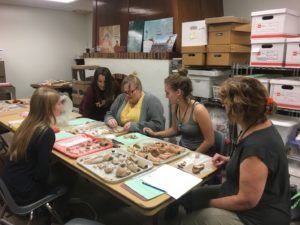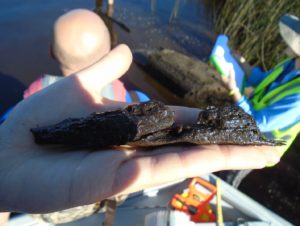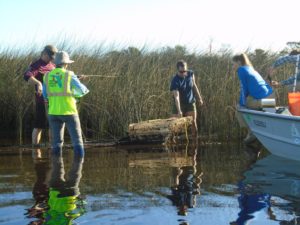The past three months have been very busy for our Lighthouse Archaeological Maritime Program (LAMP) archaeologists. They have been analyzing artifacts discovered on the Museum property during last summer’s construction of the new Maritime Archaeology & Education Center, as well as sites through St. Johns and Flagler Counties uncovered during the storms.
Our analysis started by contacting Dr. Lee Newsom, a Professor of Anthropology at Flagler College. Dr. Newsom is an expert in examining preserved plant remains from archaeological and paleontological sites as well as examining faunal remains, or bones! We were looking to determine the types of animals found in the trash pits uncovered during construction of the new Center. Once the bones were handed over, Dr. Newsom and her students at Flagler College went to work on identifying the types of animals in these pits. They came back with incredible data.

Dr. Lee Newsom directs Flagler College students on bone identification.
There are three areas we uncovered and examined: an 1880s trash pit to the north of the northern-most outdoor brick kitchen, a trash pit dating to the 1900s, and a 1930s pit near the Tin Pickle. Many of the bones in all three areas were identified as cow bones – meaning the keepers here had access to various cuts of beef on the island. Other bones included deer, turtle, snapper and turkey. All of these animals could have been caught on or around the Light Station. This knowledge brings to light the foodways of the Lightkeepers.
We also tasked Dr. Newsom and her students with dating our wood samples taken from the November canoe discovery. This canoe had shifted around during the high tides following Hurricane Irma and became quickly exposed as the high tides and storm surge subsided. To further understand the canoe, wood samples were taken by a joint team of Museum Archaeologists and the Florida Public Archaeology Network of Northeast Florida. Tests of these samples would yield dates and a wood species. Speciation is determined by looking at the wood at a cellular level and identifying grain patterns within the wood. From their microscopic data based on one of two wood samples taken from the canoe, Dr. Newsom and her students determined the canoe to be made of cypress. Dating wood is a slow process, and only requires a tiny sliver of wood to complete. The second of the two wood samples was sent to the University of Georgia’s Center for Applied Isotope Studies. The wood is dated using radiocarbon dating. Radiocarbon dating looks at the amount of Carbon 14 remaining in a decaying piece of floral or faunal remains. As life stops exchanging Carbon 14 with the environment upon death and Carbon 14 decays at a constant rate, the older the piece being sampled, the less Carbon 14 will be present in the wood.

Wood sample taken from canoe for dating and speciation.
The analysis determined that the canoe is 830 years old ± 30 years, from 1950. From today’s date, that translates to a dating of 1000 CE. This is well before the Spanish ever laid foot in Florida. While this does not make our canoe one of the oldest in the state, it is believed to be one of the oldest in Northeast Florida.

LAMP and FPAN archaeologists examine the dugout canoe.
Now that the hardest date to obtain – that of the canoe- was determined, the LAMP team moved on to finding dates for our artifacts! The artifacts discovered on site (pottery, children’s toys, housewares) provided us with dates through historical research based on shape and maker’s marks present on individual objects.
Further research can be done into both the Light Station and the canoe to provide a fuller history of the northeast region of Florida. We appreciate the willingness of Dr. Lee Newsom and her students as well as the Center for Applied Isotope Studies at UGA to aid us in discovering new areas to be explored regarding this wider maritime history.
Contributed by Archaeologist Allyson Ropp, edited by Student Intern Jayda Barnes

